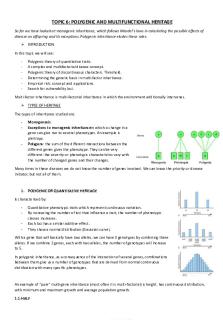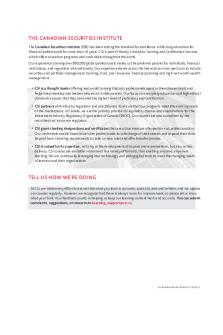UNIT 6 Notes - Canadian and American Juries PDF

| Title | UNIT 6 Notes - Canadian and American Juries |
|---|---|
| Author | Ashley Cipollone |
| Course | Introduction to Forensic Psychology |
| Institution | Brock University |
| Pages | 4 |
| File Size | 118.5 KB |
| File Type | |
| Total Downloads | 27 |
| Total Views | 138 |
Summary
Canadian and American Juries...
Description
JURIES
CHARACTERISTICS OF JURIES ●
Several different system: Adversarial system, judge not involved in collecting evidence, only making a decision basson on evidence given. Traditional “court show” style. ● Inquisitorial, based in europe. Judge is involved in the case like police officers are. ● Juries are rare, but primarily used in criminal cases, 12 people (in canada) US. is 12., must be unanimous decision in canada. Most court cases heard by judge only. Jury Selection: ● Must be representative of community as a whole, randomly selected to serve potentially as a juror. Jurors should also be unbiased and impartial: no personal connection by association, no relation to judge or prosecutor, no specific prejudice ( if you have experienced something like the case before), racial or religious prejudices, or normative prejudices (a high profile case where you may know a lot of info already). In the case of a high-profile murder, trials might be held in a different city or state where the community knows less). ● 2 STAGES: 1. Venire: receive a summons, (typically 150-150 ppl, 18 or older, must speak languages and be a citizen, no criminal record, must not be in a particular occupation). 2.) Voir dire: Lawyers question jurors, only need 12 so selected or not. If jurors are not impartial: 1. Adjournment - delay trial 2. Change location (in case of normative prejudice) 3. Peremptory challenge by a lawyer - When an attorney rejects a juror without providing a reason. Dismiss potential juror based on lawyer’s discretion. In Canadian murder trials, the defence and Crown are each allowed 20 peremptory challenges 4. Challenge for cause - dismiss potential juror based on pre-existing bias, other jurors decide. Uniquely canadian solution. Two individuals to be selected, go to witness box, 20 people called, asked to leave courtroom then brought in one at a time and asked questions by triers to see if they are biased or not. Biased juror case: Gillian Guess case - Guess was a juror in a murder trial of Peter Gill. Guess was flirting with the defendant, court reporter first noticed. Gillian guess had a sexual affair prior to trial while she was still on the jury. He was found not guilty. After this, judge found out, both convicted of obstruction of justice. Gill given 6 year sentence, 18 month for Gillian. Legal functions of juries: 1. Decide facts based on evidence. Sentencing is not responsibility of jury, but only judge in Canada. 2. Decide on a verdict (guilty or not guilty beyond any reasonable doubt). JURY SELECTION METHODS Selection is important. 2 ways that selection is determined: 1. General attitudes or personality traits of effective juries (Authoritarianism is a
key trait). Legal attitudes scale might be used, higher on scale- more likely of convicting a person.
JURIES
2. Bias - Pro defense or pro-conviction/prosecution. Can be very case specific. HOWEVER IN CANADA, NOT ALLOWED TO QUESTION JURORS. IN US. YOU CAN ASK ANYTHING. ○ Jury Consultants identify characteristics of an ideal jury to have for that case, and which to avoid, do survey, mock trials etc. - OJ Simpson trial had these question. Talks to Lawyer about the results and makes a decision. ○ Trial Consultants are present for the whole trial. Help select expert witnesses, prepare witnesses (what to wear, where to look, what to say ect), interpret experts response, develop cross exam questions. How do juries perceive these trial consultants? Juries question these things, 18% would be biased against a side that would hire a consultant. Models proposed: 1. Mathematical model - juries sit in jury box and listen to evidence and weigh all evidence and decide who has more compelling evidence. Juries DO NOT DO THIS. 2. Story model is used. Jurors come to courtroom with bias and notions, listen to opening statement and make a narrative, as evidence is presented by various sources, they fill in all the gaps. Any missing gaps they fill it in themselves. Judge gives them different verdicts to come back with. Upon decision making, they match verdict to story. Decide based on this. Most empirical support to what actually happens. METHODS OF STUDYING JURORS 1. Post Trial Interviews w/ jurors (“Can I interview you?”): Not done in Canada (forbidden by law), but in US. May not be able to account for what happened. 2. Archival studies - look at information of trial, and what happened, very limited info. 3. Field studies - go sit in courthouse and observe what is happening. Observe jury. 4. Simulation studies - bring students in lab or online, do mock trial, questioning of witnesses, examination, defendant testimony etc. High external validity. Backfire effect: inadmissible info being forbidden to use is now considered important. Inadmissible study - no wiretap (cntrl), Admissible group, 2 inadmissible groups: wiretap too soft to hear, illegally obtained. All hear same vignette. In cntl, 24% said yes to guilty, in Admitted, 79% said yes, in inadmissible by too soft, 24% said yes, BUT illegally obtained, still 55% said guilty. Mock jury failed to disregard evidence. >There was no difference in guilty verdicts between the following 2 experimental conditions: control who did not hear the wiretap confession and the disregard due to poor comprehension. ● Jury Nullification - ignore the law to find defendant not guilty despite lots of evidence.
JURIES
● As it currently stands in Canada, the practice of jurors asking questions and taking notes is determined by judge. Note taking by jurors has been proposed as one possible way of improving juror comprehension. However, a number of researchers have pointed out that note taking is a potential problem due to Jurors who have taken notes may exert an undue influence over those who haven't. WHAT PREDICTS VERDICTS ● Rcial effect, race matters. Other race effect - more likely to give guilty verdict and harsher penalty. For weak evidence: Similarity leniency hypothesis: same race as you, more likely to be lenient toward that individual. However, if strong evidence, called black sheep effect., more harshly, trying to distance oneself. ● Research study - Baldus study, 1983. - who you kill matters: white man - 11% death penalty, only 1% if black. ● Defendant’s race and victim’s race - If defendant was black and killed white 22%, black killed black - 1%. ● Race: Are black individuals more ‘death worthy’? Uni students to rate how stereotypically black photos looked. Looking for darker skin, flatter nose, thick lips. Then, looked to see what happened in the trials. If victims was white ● there would be an interaction effect. Less “black” - 24% d.p. More black - 58% If black victim: 47%, 45%, respectively. Race does matter in death penalty cases. ● Gender: less harsh on females, male jurors less punitive, females jurors less punitive unless sexual abuse/assault cases. ● Obesity: Fat females get convicted more by male mock juries. Females did not have any effect. ● According to a study by Sundby (1997) on jurors' perceptions of different types of witnesses, a professional expert would be viewed most negatively THE CSI EFFECT ● Jurors may expect to see DNA evidence, which might affect decisions. Very unrealistic crime scene analects and processes. This can affect jurors expectations of cases. ● 45% had watched Law and Order, and 42% watched CSI. Watching these shows is very prevalent. Type of crime
Some sci evidence DNA
Fingerprint
Every crime
58%
42%
57%
Murder
84%
75%
85%
Assault
55%
49%
54%
JURIES
Rape
83%
89%
41%
B&E
59%
32%
84%
● Fingerprint and DNA evidence not very likely- only 10% of 2004 homicide cases. Evidence more circumstantial. By far most common in criminal case....
Similar Free PDFs

American History Unit 2 Notes
- 8 Pages

Unit 6 - Lecture notes Unit 6
- 1 Pages

Unit 06 - Unit 6 notes
- 3 Pages

Unit 6 - Lecture notes 6
- 7 Pages

Unit 6 - Lecture notes 6
- 5 Pages

Unit 6 Notes
- 3 Pages

Unit 6 - notes
- 58 Pages

Unit 1 - Lecture notes 6
- 59 Pages

Unit 6 Devolution and Federalism
- 12 Pages

American Graffiti - Apuntes 6
- 2 Pages

Resumen American Civilization Unit 1
- 10 Pages

Worksheet 6-Unit 6
- 1 Pages

Unit 6 lab - Unit 6 lab
- 1 Pages
Popular Institutions
- Tinajero National High School - Annex
- Politeknik Caltex Riau
- Yokohama City University
- SGT University
- University of Al-Qadisiyah
- Divine Word College of Vigan
- Techniek College Rotterdam
- Universidade de Santiago
- Universiti Teknologi MARA Cawangan Johor Kampus Pasir Gudang
- Poltekkes Kemenkes Yogyakarta
- Baguio City National High School
- Colegio san marcos
- preparatoria uno
- Centro de Bachillerato Tecnológico Industrial y de Servicios No. 107
- Dalian Maritime University
- Quang Trung Secondary School
- Colegio Tecnológico en Informática
- Corporación Regional de Educación Superior
- Grupo CEDVA
- Dar Al Uloom University
- Centro de Estudios Preuniversitarios de la Universidad Nacional de Ingeniería
- 上智大学
- Aakash International School, Nuna Majara
- San Felipe Neri Catholic School
- Kang Chiao International School - New Taipei City
- Misamis Occidental National High School
- Institución Educativa Escuela Normal Juan Ladrilleros
- Kolehiyo ng Pantukan
- Batanes State College
- Instituto Continental
- Sekolah Menengah Kejuruan Kesehatan Kaltara (Tarakan)
- Colegio de La Inmaculada Concepcion - Cebu


